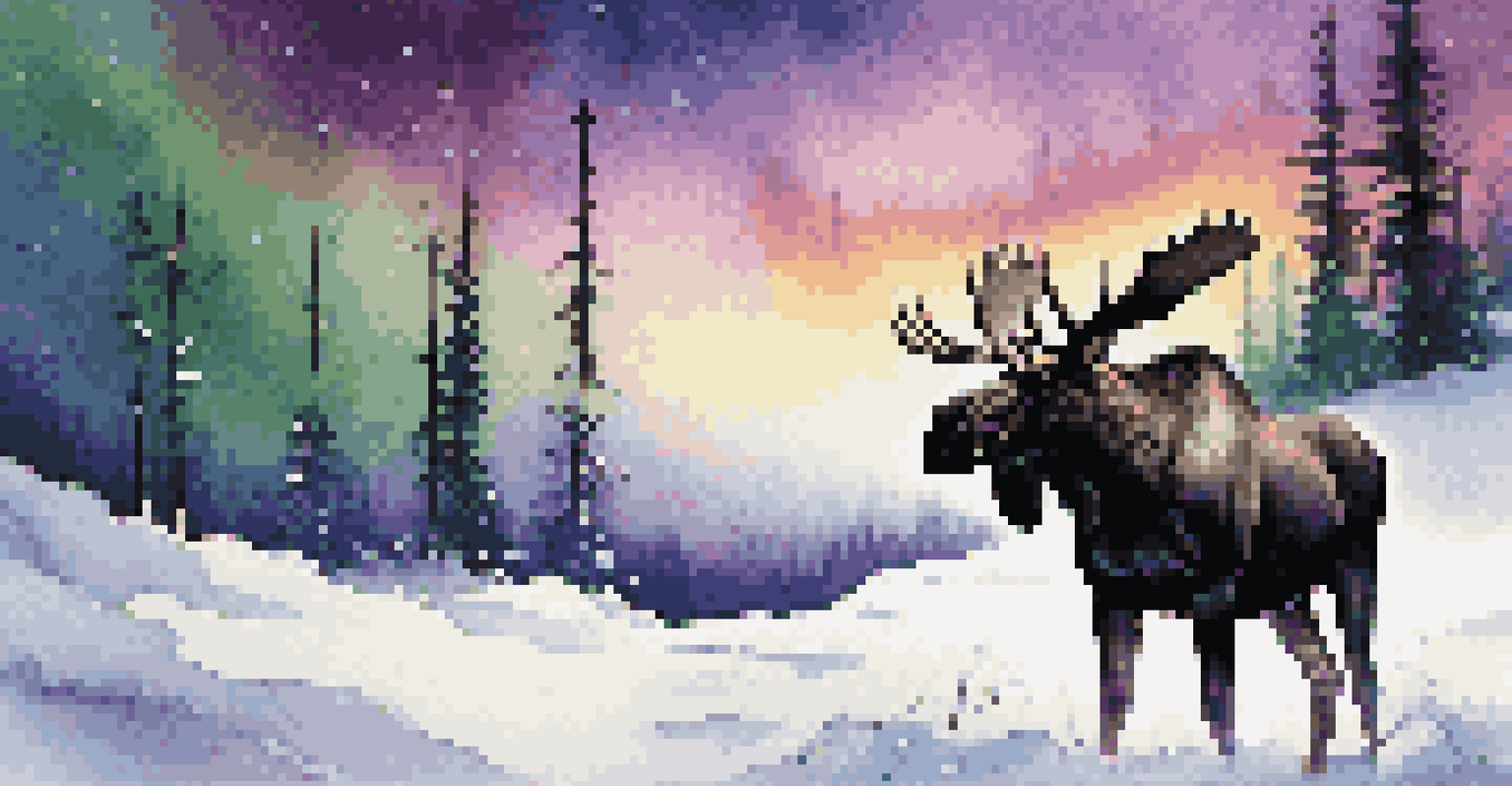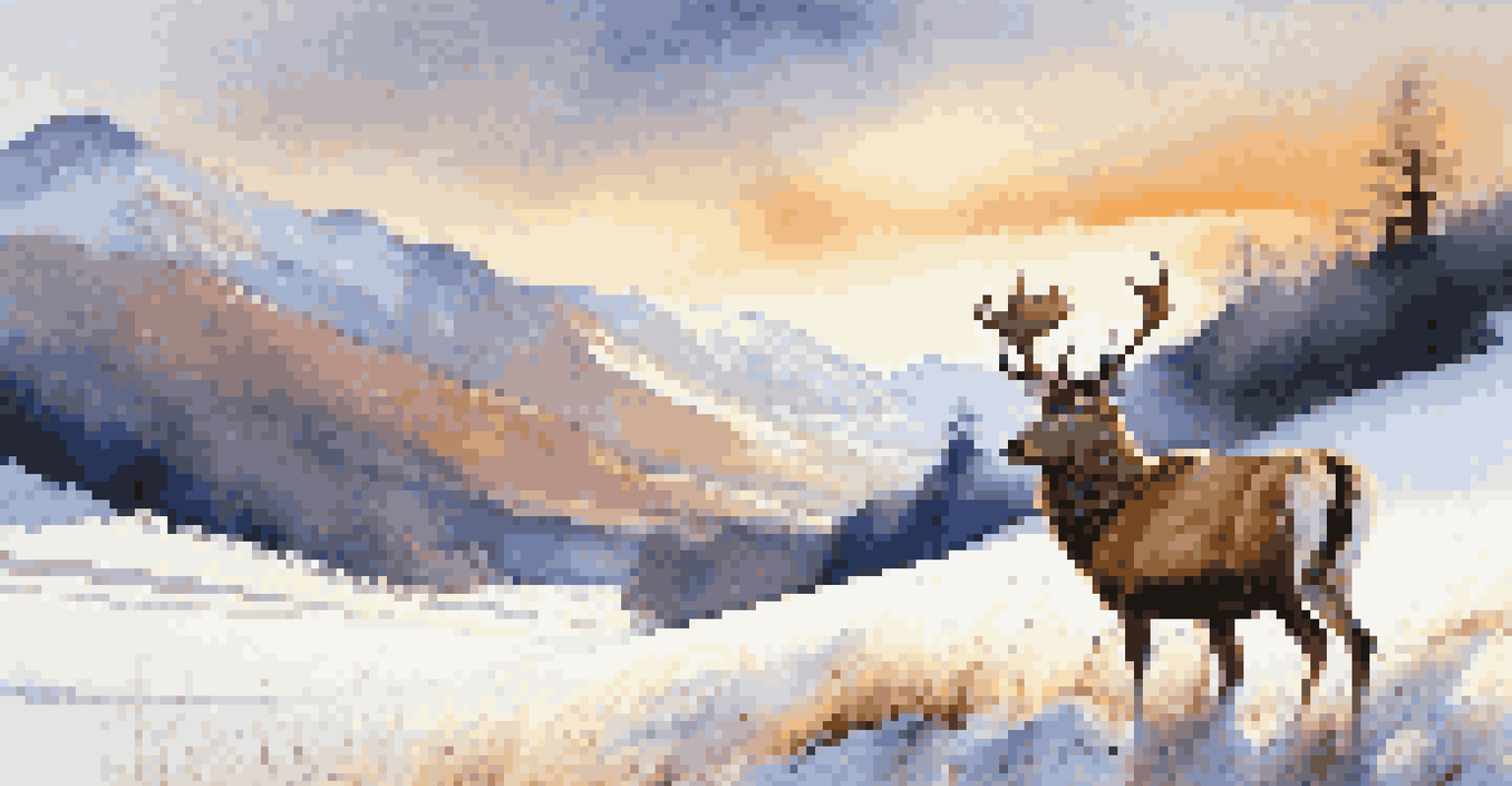Winter Wildlife: Best Destinations for Animal Encounters

Understanding Winter Wildlife and Their Habitats
Winter transforms landscapes and the animals that inhabit them. Many species adapt to the colder months by changing their behavior or appearance, such as white-tailed deer growing thicker coats. Understanding these adaptations helps us appreciate the resilience of wildlife during harsh conditions.
In every walk with nature one receives far more than he seeks.
Animals like bears hibernate, while others, like wolves, remain active and hunt in packs. This seasonal shift creates unique opportunities for wildlife enthusiasts to witness these behaviors in their natural settings. Observing these adaptations not only fosters a deeper connection with nature but also highlights the importance of conservation efforts.
In many regions, winter is an ideal time for wildlife watching as animals are often more visible against the stark, snowy backdrops. With a little preparation and knowledge, you can enhance your experience while exploring the great outdoors during this magical season.
The Enchanting Yellowstone National Park in Winter
Yellowstone National Park is a winter wonderland, attracting wildlife lovers from all over. In the snowy months, you can spot bison, elk, and even wolves roaming the park's vast expanse. The stark beauty of the landscape adds an enchanting layer to your wildlife encounters.

One of the best ways to explore Yellowstone in winter is through guided snowshoe or snowmobile tours. These tours not only offer safety but also provide expert insights into the park's diverse wildlife. Imagine trekking through silent, snow-laden forests, with the occasional sighting of a majestic animal in its natural habitat.
Winter Wildlife Adaptations
Many animals adapt to winter by changing behavior or appearance, showcasing their resilience in harsh conditions.
Additionally, hot springs and geysers create a fascinating contrast against the cold, drawing animals seeking warmth. The unique combination of wildlife and geothermal activity makes Yellowstone a must-visit destination for winter animal encounters.
Experience the Arctic Wildlife of Alaska
Alaska's rugged wilderness is a prime destination for those seeking winter wildlife encounters. From the breathtaking Northern Lights to the resilient wildlife, this region offers an unforgettable experience. You might catch a glimpse of moose, caribou, and even the elusive lynx as you explore the snowy landscape.
Wildlife and its habitat cannot speak, so we must and we will.
Many tour operators offer guided excursions that focus on wildlife viewing in the winter months. These guided trips often include activities like dog sledding or snowmobiling, making your adventure even more thrilling. Imagine gliding through pristine snow while watching for wildlife along the way.
One unique aspect of Alaskan winter wildlife is the chance to observe migratory birds that stop in the region to feed. This unexpected twist adds an extra layer of excitement to your wildlife experience, showcasing the incredible diversity of life that thrives in these cold conditions.
The Unique Wildlife of Banff National Park in Canada
Banff National Park is a winter paradise, showcasing an array of wildlife against a stunning mountain backdrop. Here, you can spot animals like elk, deer, and even the occasional grizzly bear, all adapting to the winter months. The park's diverse ecosystems provide a perfect habitat for these creatures.
Winter activities such as skiing and snowshoeing can lead to unexpected wildlife encounters. As you navigate the snowy trails, keep your eyes peeled for animal tracks in the snow, which can tell you a lot about the wildlife in the area. It's like nature's own treasure map, guiding you to the creatures that call Banff home.
Top Destinations for Wildlife Watching
Places like Yellowstone, Alaska, and Banff offer unique opportunities to observe diverse wildlife in stunning winter landscapes.
With its breathtaking scenery and rich wildlife, Banff offers a unique opportunity to connect with nature during the winter months. The contrast of the snow-covered landscape and the vibrant life it supports makes for an unforgettable experience.
Exploring the Polar Bear Capital: Churchill, Manitoba
Churchill, Manitoba, often dubbed the 'Polar Bear Capital of the World,' is an extraordinary place to witness these majestic creatures in winter. Every year, polar bears migrate towards the Hudson Bay, and Churchill becomes their waiting ground before the sea ice forms. This unique migration draws wildlife enthusiasts and photographers alike.
Specialized tours offer guided experiences, allowing you to observe polar bears from the safety of tundra buggies. These vehicles provide a unique vantage point to view the bears in their natural habitat without disturbing them. Imagine watching a polar bear traverse the snowy landscape, its white fur blending seamlessly with the surroundings.
In addition to polar bears, Churchill is also a great spot for birdwatchers in the winter months. Snowy owls and other avian species can be spotted, adding to the rich tapestry of wildlife that makes this destination so special.
Wildlife Watching in the Smoky Mountains During Winter
The Great Smoky Mountains National Park offers an enchanting winter escape filled with wildlife encounters. During the colder months, various species, including black bears, deer, and wild turkeys, can be spotted against the serene, snow-covered backdrop. The crisp mountain air and scenic views create a magical atmosphere for wildlife enthusiasts.
Winter is also a quieter time in the park, allowing for more intimate wildlife viewing experiences. With fewer visitors, you might find yourself observing animals in their natural environment without the distractions of crowds. This peacefulness enhances your connection with nature, making for a truly memorable outing.
Responsible Wildlife Viewing Tips
Practicing responsible wildlife watching enhances your experience while protecting animals and their habitats.
Additionally, the park's diverse ecosystems provide habitats for numerous species, making it a prime location for wildlife observation. The beauty of the Smoky Mountains in winter, combined with its rich wildlife, creates an unforgettable adventure.
The Winter Wildlife of the Scottish Highlands
The Scottish Highlands offer a stunning winter landscape filled with unique wildlife encounters. Here, you can spot red deer, golden eagles, and even the elusive pine marten as they adapt to the cold weather. The rugged beauty of the highlands makes it an incredible backdrop for wildlife watching.
Many visitors enjoy guided wildlife tours that delve into the region's rich biodiversity. These tours often include hikes through snowy forests and visits to remote areas, increasing your chances of spotting wildlife. Imagine trekking through the serene landscape, with the thrill of encountering a majestic stag in the distance.

Winter in the Highlands also brings a sense of tranquility, allowing for reflective moments in nature. The combination of breathtaking scenery and fascinating wildlife creates a truly enchanting experience for anyone looking to connect with the wild.
Tips for Responsible Wildlife Watching in Winter
As you embark on your winter wildlife adventures, it's crucial to practice responsible wildlife watching. Keeping a safe distance from animals not only protects their natural behavior but also ensures your safety. Binoculars can be a great tool for observing wildlife from afar without disturbing them.
Respecting wildlife habitats is equally important. Stick to marked trails and avoid venturing into sensitive areas where animals may be nesting or resting. By minimizing our impact on their environment, we can help ensure that these wonderful creatures thrive for generations to come.
Lastly, educate yourself about the wildlife in the area you plan to visit. Understanding their behaviors, habitats, and the challenges they face can enhance your experience and promote a deeper appreciation for these incredible animals. With a little knowledge and respect, your winter wildlife encounters can be both enjoyable and sustainable.